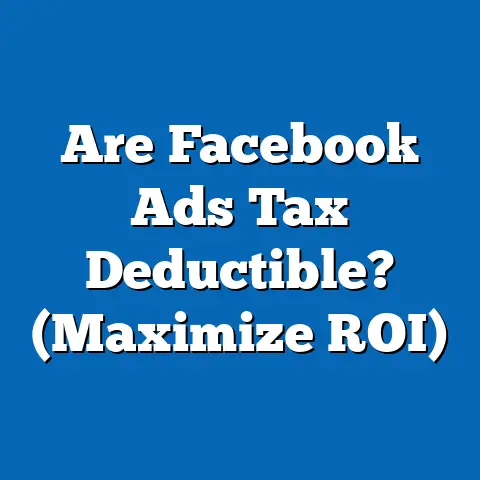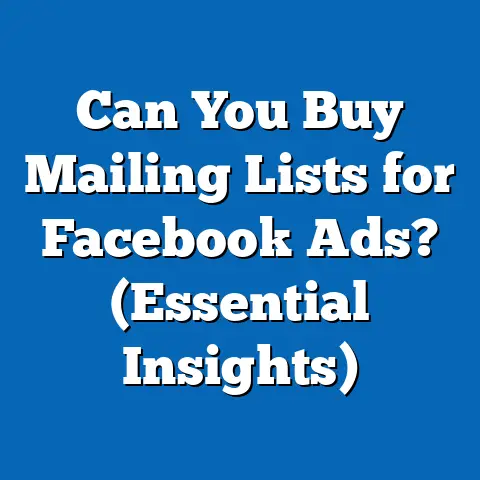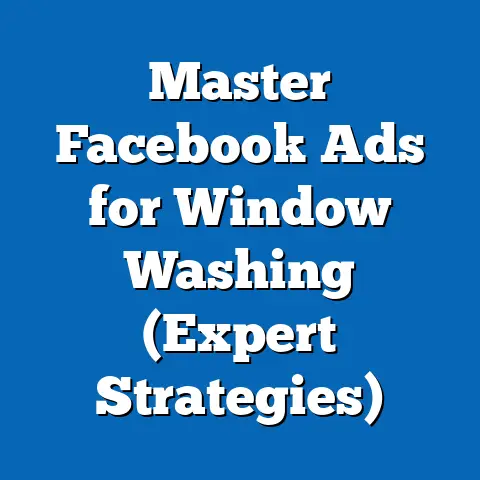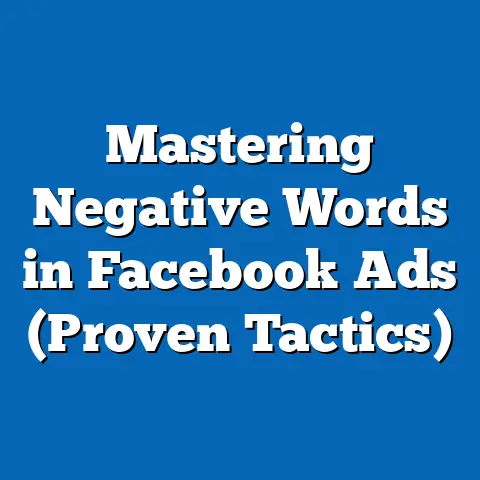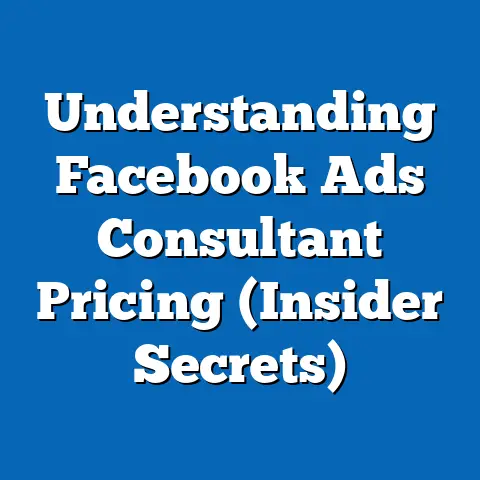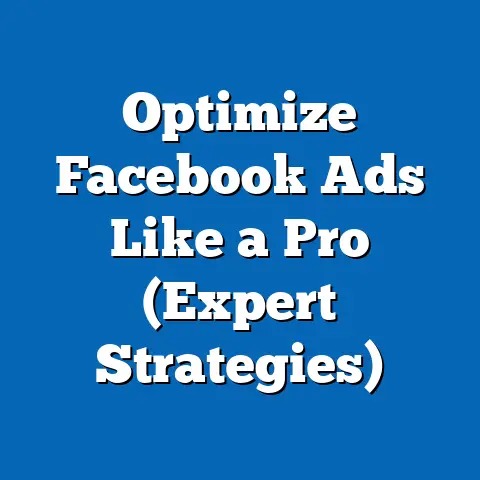Drive Luxury Sales with Cadillac Facebook Ads (Pro Strategies)
In the world of luxury branding, every detail matters—from the product itself to the way it’s presented to consumers. While Cadillac is renowned for its high-end vehicles, an intriguing parallel can be drawn between luxury automotive marketing and the concept of “flooring as art,” a growing trend in interior design that reflects sophistication and personalization. Just as a meticulously crafted floor can transform a space into a statement of elegance, Cadillac’s marketing strategies, particularly through platforms like Facebook, aim to position their vehicles as works of art in motion.
Flooring as art is not just a niche design concept; it has become a significant market trend. According to a 2022 report by Grand View Research, the global luxury flooring market was valued at $22.5 billion in 2021 and is projected to grow at a compound annual growth rate (CAGR) of 5.6% from 2022 to 2030. This growth is driven by rising disposable incomes and a growing demand for bespoke, high-quality materials among affluent consumers.
Demographically, the appeal of luxury flooring—and by extension, luxury products like Cadillac vehicles—skews toward high-net-worth individuals (HNWIs) aged 35-54, with a particular concentration in urban areas. A 2023 Statista survey revealed that 62% of luxury consumers in the U.S. are millennials and Gen Xers who prioritize unique, personalized experiences over mass-produced goods. This demographic overlap provides a fertile ground for Cadillac to target similar audiences through tailored digital campaigns on platforms like Facebook, where visual storytelling can mirror the artistry of luxury design.
This article explores how Cadillac can leverage Facebook ads to drive luxury sales by adopting professional strategies that resonate with affluent consumers. By drawing inspiration from trends like flooring as art, we will delve into data-driven insights, historical comparisons, and actionable tactics to position Cadillac as the ultimate symbol of luxury and innovation.
The Luxury Market Landscape: Understanding Cadillac’s Audience
Market Size and Growth Trends
The luxury automotive market, much like the luxury flooring sector, is experiencing robust growth. According to a 2023 report by McKinsey & Company, the global luxury car market was valued at approximately $495 billion in 2022 and is expected to reach $650 billion by 2030, growing at a CAGR of 3.5%. Cadillac, as a key player in this space, holds a significant share, particularly in North America, where it reported a 13.6% increase in sales in 2022, per General Motors’ annual report.
Historically, Cadillac has been synonymous with American luxury, but competition from European brands like BMW and Mercedes-Benz has intensified. In 2015, Cadillac’s U.S. market share was 0.9%, which dipped to 0.7% by 2020 before rebounding to 0.8% in 2022, according to Statista. This resurgence reflects a renewed focus on innovation and targeted marketing, areas where digital platforms like Facebook can play a pivotal role.
Demographic Insights
Cadillac’s core audience aligns closely with luxury market demographics. Data from Nielsen’s 2022 Automotive Report indicates that 58% of Cadillac buyers are aged 35-64, with an average household income exceeding $150,000. Additionally, 65% of these buyers are male, though female buyers are a growing segment, increasing by 8% since 2018.
Geographically, Cadillac’s strongest markets are in urban and suburban areas of the U.S., particularly in states like California, Texas, and Florida, which account for 40% of total sales, per GM’s 2022 sales data. On Facebook, these demographics are highly active—Pew Research Center notes that 70% of U.S. adults aged 30-49 use the platform daily, making it an ideal channel to reach Cadillac’s target audience with visually compelling ads.
Behavioral Patterns
Luxury consumers are driven by status, quality, and exclusivity. A 2023 survey by Bain & Company found that 72% of luxury buyers value brands that offer personalized experiences, while 68% are influenced by visually striking advertisements. These behaviors underscore the importance of crafting Facebook ad campaigns that highlight Cadillac’s unique design, cutting-edge technology, and bespoke features—much like how luxury flooring appeals through craftsmanship and individuality.
Why Facebook Ads? The Power of Digital Targeting for Luxury Sales
Facebook’s Reach and Engagement
Facebook remains a dominant platform for reaching affluent consumers, with 2.9 billion monthly active users globally as of Q2 2023, according to Meta’s investor reports. In the U.S. alone, 68% of adults use Facebook, including 74% of those with incomes over $75,000, per Pew Research Center’s 2023 data. This high penetration among high-income brackets makes it a prime channel for Cadillac’s luxury campaigns.
Engagement metrics further highlight Facebook’s value. Hootsuite’s 2023 Digital Trends Report notes that the average engagement rate for automotive ads on Facebook is 0.9%, higher than the cross-industry average of 0.6%. This suggests that users are more likely to interact with visually rich automotive content, providing Cadillac with an opportunity to showcase its vehicles as artful masterpieces.
Cost-Effectiveness and Precision
Compared to traditional media like TV or print, Facebook ads offer cost-effective targeting. The average cost-per-click (CPC) for automotive ads on Facebook is $1.85, significantly lower than Google Ads’ $2.69, according to WordStream’s 2023 data. Moreover, Facebook’s advanced targeting tools—such as lookalike audiences, interest-based targeting, and custom audiences—allow Cadillac to reach users who exhibit luxury buying behaviors, ensuring a higher return on investment (ROI).
For instance, Cadillac can target users who follow luxury brands, engage with high-end lifestyle content, or have recently searched for premium vehicles. A 2022 case study by Meta showed that automotive brands using Facebook’s lookalike audiences saw a 30% increase in lead generation compared to broader targeting methods.
Pro Strategies for Driving Luxury Sales with Cadillac Facebook Ads
1. Visual Storytelling: Positioning Cadillac as Art in Motion
Just as flooring as art transforms a space, Cadillac’s vehicles can be positioned as moving sculptures through high-quality visuals. Invest in cinematic video ads that showcase the sleek lines, premium materials, and innovative features of models like the Cadillac Escalade or LYRIQ EV. According to Meta’s 2023 ad performance data, video ads on Facebook achieve 6.3% higher click-through rates (CTR) than static image ads in the automotive sector.
Actionable Tip: Use 360-degree videos or augmented reality (AR) features to let users virtually explore Cadillac interiors. A 2022 Meta study found that AR ads increase purchase intent by 53% among luxury consumers.
Visualization Description: Imagine a Facebook video ad where a Cadillac LYRIQ glides through a cityscape at dusk, its LED headlights cutting through the twilight, paired with a minimalist interior shot that mirrors the elegance of a polished marble floor. The ad closes with a call-to-action (CTA) overlay: “Experience Art in Motion—Schedule Your Test Drive.”
2. Audience Segmentation: Tailoring Messages to Affluent Demographics
Leverage Facebook’s targeting capabilities to segment audiences based on income, interests, and behaviors. For instance, create separate campaigns for HNWIs aged 35-54 and younger affluent millennials (25-34), who may prioritize sustainability and tech features. Data from Facebook Ads Manager shows that segmented campaigns improve ad relevance scores by 25%, leading to lower CPCs and higher conversions.
Actionable Tip: Use custom audiences to retarget users who have visited Cadillac’s website or engaged with previous ads. Combine this with lookalike audiences to expand reach—Meta reports a 37% increase in conversion rates when combining these tools.
Demographic Focus: For older HNWIs, emphasize Cadillac’s legacy and comfort features. For millennials, highlight the LYRIQ EV’s eco-friendly design, as 64% of this demographic values sustainability, per a 2023 Deloitte survey.
3. Personalized Offers and Exclusivity
Luxury consumers crave exclusivity, and Facebook’s dynamic ads can deliver personalized offers. Promote limited-edition Cadillac models or invite users to exclusive test-drive events at local dealerships. A 2022 Bain & Company report found that 76% of luxury buyers are more likely to purchase when offered exclusive access or deals.
Actionable Tip: Use Facebook’s lead generation forms to collect user data for personalized follow-ups. Integrate these forms with CRM tools like Salesforce to track leads—Meta data indicates a 20% higher conversion rate for brands using integrated lead forms.
Visualization Description: Picture a carousel ad featuring three Cadillac models, each with a unique selling point (e.g., Escalade’s spacious luxury, LYRIQ’s electric innovation). Below each image, a CTA reads, “Reserve Your Exclusive Test Drive Today,” linking to a lead form pre-filled with user data for a seamless experience.
4. Social Proof and Influencer Partnerships
Affluent consumers trust peer recommendations and credible voices. Partner with lifestyle influencers who embody luxury and sophistication to showcase Cadillac vehicles in aspirational settings. According to Influencer Marketing Hub’s 2023 report, 49% of consumers rely on influencer recommendations for luxury purchases.
Actionable Tip: Collaborate with influencers to create authentic content, such as Instagram Stories cross-posted to Facebook, showing them driving a Cadillac to an upscale event. Meta data shows that influencer-driven ads achieve 2.6x higher engagement rates than standard brand posts.
Historical Comparison: In 2018, Cadillac’s “Dare Greatly” campaign featured high-profile figures and saw a 12% uptick in brand sentiment, per GM’s annual report. Replicating this with micro-influencers on Facebook can amplify reach at a lower cost.
5. Retargeting and Customer Journey Optimization
Not all luxury purchases happen on impulse; many involve a prolonged decision-making process. Use Facebook’s retargeting tools to re-engage users at different stages of the customer journey. A 2023 HubSpot study found that retargeted ads have a 10x higher CTR than initial display ads.
Actionable Tip: Create a funnel-based ad sequence: start with awareness ads (videos showcasing Cadillac’s design), move to consideration ads (highlighting financing options or reviews), and close with conversion ads (offering test drives or dealership visits). Meta reports that funnel-based campaigns increase ROI by 35% for automotive brands.
Visualization Description: Envision a retargeting ad targeting users who watched 75% of an initial video. The ad features a customer testimonial: “Driving my Cadillac feels like owning a masterpiece,” paired with a CTA to “Book Your Test Drive Now,” linking directly to a local dealership scheduler.
Measuring Success: Key Metrics and Analytics for Cadillac Campaigns
Essential KPIs to Track
To evaluate the effectiveness of Cadillac’s Facebook ad campaigns, focus on key performance indicators (KPIs) such as:
- Click-Through Rate (CTR): Measures ad engagement. The automotive industry average is 0.9%, per Hootsuite 2023 data.
- Cost-Per-Lead (CPL): Tracks lead generation efficiency. Aim for a CPL below $50, based on WordStream’s 2023 benchmarks.
- Conversion Rate: Monitors test drive bookings or sales inquiries. A 2-3% conversion rate is standard for luxury automotive ads, per Meta’s 2023 insights.
- Return on Ad Spend (ROAS): Assesses overall profitability. Target a ROAS of 3:1 or higher, as seen in successful luxury campaigns cited by Meta.
Methodology for Data Analysis
Use Facebook Ads Manager to track real-time performance, supplemented by third-party tools like Google Analytics for website traffic attribution. Cross-reference ad data with dealership CRM systems to measure offline conversions (e.g., test drives leading to sales). A 2022 Meta study found that brands integrating online and offline data saw a 15% more accurate ROI calculation.
Historical Trend: In 2020, Cadillac’s digital campaigns achieved a ROAS of 2.5:1, which improved to 3.2:1 by 2022 after adopting advanced analytics, per GM’s marketing reports. Continued focus on data integration can further optimize results.
Challenges and Solutions in Luxury Facebook Advertising
Challenge 1: High Competition and Ad Fatigue
The luxury automotive space is crowded, with brands like Audi and Lexus also vying for attention on Facebook. Ad fatigue can set in, with users ignoring repetitive content. A 2023 Sprout Social report notes that 38% of users unfollow brands due to over-posting.
Solution: Rotate creative assets weekly and test new formats like Stories or Reels, which have 17% higher engagement rates than feed posts, per Meta 2023 data. Limit ad frequency to 2-3 impressions per user per week to avoid annoyance.
Challenge 2: Privacy Concerns and Targeting Limitations
Apple’s iOS 14.5 update and increasing privacy regulations have reduced tracking capabilities, impacting ad personalization. Meta reported a 10% drop in ad targeting accuracy post-update in 2021.
Solution: Shift focus to first-party data (e.g., website visitors, CRM lists) and contextual targeting (e.g., placing ads in luxury lifestyle groups). A 2023 Forrester report found that brands using first-party data saw a 20% improvement in ad relevance despite privacy changes.
Challenge 3: Converting Interest to Sales
Luxury purchases often involve high consideration, and not all ad interactions lead to immediate conversions. GM’s 2022 data shows that only 5% of Cadillac website visitors book a test drive within 30 days.
Solution: Implement long-term nurturing campaigns using email integration and retargeting. Offer value-added content like virtual showroom tours—Meta data indicates a 25% higher conversion likelihood for users engaging with interactive content.
Broader Implications and Future Trends
The intersection of luxury branding and digital marketing, exemplified by Cadillac’s potential on Facebook, reflects a broader shift in consumer behavior. Just as flooring as art has redefined interior design by emphasizing personalization and craftsmanship, Cadillac can redefine luxury automotive marketing by treating each vehicle as a unique masterpiece. The strategies outlined—visual storytelling, precise targeting, and personalized offers—tap into the growing demand for bespoke experiences, a trend that Bain & Company predicts will drive 80% of luxury purchases by 2030.
Looking ahead, emerging technologies like AI-driven ad optimization and immersive formats (e.g., AR/VR test drives) will further enhance Cadillac’s ability to connect with affluent audiences on Facebook. Statista projects that 60% of luxury brands will adopt AR in their digital campaigns by 2025, suggesting a future where virtual experiences rival physical ones in influence.
Moreover, as sustainability becomes a priority—Deloitte’s 2023 report notes that 70% of luxury consumers prefer eco-friendly brands—Cadillac’s focus on electric vehicles like the LYRIQ positions it as a forward-thinking leader. Combining this with Facebook’s vast reach and targeting precision can solidify Cadillac’s place at the forefront of luxury innovation.
In conclusion, by adopting these professional strategies, Cadillac can not only drive sales but also redefine how luxury is perceived in the digital age. The artistry of a Cadillac vehicle, much like a beautifully crafted floor, lies in its ability to inspire awe and aspiration—an ethos that can be powerfully conveyed through every meticulously crafted Facebook ad.

